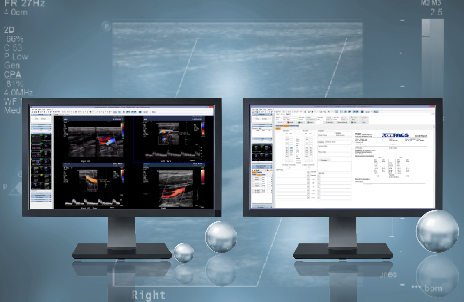- Integration with the Hospital Order Entry system will provide Modality Worklist distribution to the ultrasound machine, allowing the operator to easily set up and start the case.
- Vascular images and loops, as well as measurements performed on the ultrasound machine during the vascular ultrasound examination, are captured during the procedure and securely stored to the ComPACS archive.
- After the vascular ultrasound examination, the study is immediately available in ComPACS for the physician to review, analyze and report the vascular study.
- ComPACS provides analysis and reporting templates for various study types including, but not limited to: Carotid, Lower Extremity Arteries, Lower Extremity Veins, Upper Extremity Arteries, Lower Extremity Veins, Viscera.
- Both Analysis and Reporting can be fully customized to meet your specific workflow needs, with user defined measurements and structured findings.
- All anatomically specified measurements automatically populate into the report worksheet and final document to save you time and eliminate potential transcription errors.
- The system keeps track of the graphical tracing and exact image and frame position of where each measurement is taken, for quality or trial auditing purposes.
- ComPACS vascular reporting provides a comprehensive set of predefined vascular structured findings, allowing the physician to simply click on anatomic tabs, and then selecting the desired function and/or pathology check boxes to complete the narrative content of a report quickly and easily.
- Streamlines workflow by enabling physicians to view, complete and sign vascular ultrasound reports from the hospital, office or home.
- Using the vascular ultrasound structured reporting tool enables confirmed and electronically signed reports to be automatically routed directly to the HIS/EMR, making the vascular report generated in ComPACS directly available in the electronic patient journal as a document.

